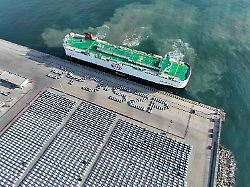Flood of electric cars from the Far East from 2025?
China’s car manufacturers build their own ships for export
By Diana Dittmer
January 17, 2024, 5:31 p.m
The expansion plans of Chinese electric car manufacturers into Europe are encountering practical obstacles. Buyers in the West are not only more skeptical than expected. There is also a lack of freighters to bring the vehicles to Europe. BYD, Saic & Co. react.
The planned conquest of Chinese electric car manufacturers into Europe is a long time coming. It could still be years before cars from China overtake the continent, as the Chinese government imagines. This is not only due to the reluctance to buy in the traditional car strongholds in Europe, but also to a serious bottleneck in freight traffic across the world’s oceans: there are no suitable ships for the cars. China’s car manufacturers are therefore taking countermeasures at Beijing’s behest. The export figures should finally rise faster.
According to Handelsblatt, there are around 700 car transporters worldwide, less than 100 of which belong to China. What makes matters worse is that only a fraction are suitable for crossing to Europe. That is simply not enough to flood the world market with the vehicles that Chinese car manufacturers are now producing in large numbers for export.
The industry is not only suffering from the loss of transport capacity that occurred during the pandemic, when global demand for new cars collapsed in 2020. At that time, aging roll-on/roll-off ships (“Ro-Ro”) were simply scrapped. In addition, no new orders were placed at the same time because of the discussion about more climate-friendly shipping fuels in the future, as the paper writes, citing a study by the London shipping consultancy Clarksons.
Despite the bottlenecks in transport options, Chinese car manufacturers are continuing to accelerate production for export. As the Center of Automotive Management (CAM) and the Mercator Institute for China Studies (Merics) have calculated, China is likely to have overtaken Japan as the world’s largest car exporter last year. While fewer than a million vehicles were transported around the world in 2020, by 2023 there were an estimated four million – a record figure. A large proportion of them ended up in Europe, one in three of them was an electric car. The booming car manufacturing meant overproduction: cars that could not be exported ended up in parking lots and car graveyards. In 2022, around a million cars are said to have stopped because there were no transport options.
There is a wide gap between supply and demand
There is no quick improvement in sight. On the contrary, the situation could even get worse, because almost half of the ships suitable for transporting cars are now older than 15 years and will have to be decommissioned in the foreseeable future. Even if the freighters are ordered now, they will not be delivered for another three years. A problem that does not affect China alone: Clarksons’ figures show that total global freight capacities only increased by two percent in 2019, while sea trade in vehicles climbed by seven percent to a record level of almost 24 million vehicles in 2023 alone.
The increased freight rates reflect the mismatch between supply and demand: car manufacturers worldwide had to shell out $115,000 per day for a ship charter in 2023, which corresponded to an increase of ten percent within one year. For China’s exports to Europe, the increase in freight rates was even steeper, partly because of the disruptions in the Red Sea since the outbreak of the Israeli war and the stricter requirements for ship diesel. According to a ship broker, transporting a vehicle from China to Europe twelve months ago cost between $580 and $670. It currently costs around $700 to $800.
The Chinese car market is largely saturated with electric cars. Beijing is therefore pushing to increase export figures more quickly. Some Chinese car manufacturers and shipping companies have therefore already reacted and expanded their own fleet. BYD put its first car transport ship, the Explorer 1, into service in December. Another eight ships worth around 640 million euros are planned.
Orders for ships with record capacities
BYD is not only China’s most important electric car manufacturer, but now also one of the largest in the world. Extrapolated for 2023, BYD had around 206,000 export units – a fourfold increase compared to 2022. The company’s own fleet of special car freighters is intended to accelerate the expansion of “Build your Dreams”, as the group is officially called, in the future.
Saic, a cooperation partner of General Motors and Volkswagen in China, also expanded its fleet. At the end of August last year, the company launched the “H2659”. The ship will travel between China and Europe as well as Australia. Twelve more ships with a record capacity of up to 9,000 cars have been ordered. They are scheduled to enter service by 2026. The Chinese state-owned shipping company Cosco, which has previously focused primarily on container trading, is also pushing into the automobile transport market.
Supply problems due to a lack of transport options have not yet been felt in sales in this country; the port areas in Bremerhaven and Cuxhaven are parked with Chinese cars. The market share of new Chinese homeopathic registrations in Germany is 1.3 percent. Will the wave of electric cars that Beijing wants continue to build towards the West? The long-time President of the EU Chamber of Commerce in Beijing, Jörg Wuttke, assumes this. He predicts the much-discussed “car tsunami” for the time when the freighters are ready for use from 2025. In the automotive sector there will then be “a brutal predatory battle and price war,” “Manager Magazin” quotes him as saying. However, this also assumes that acceptance among buyers has grown by then.
